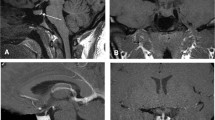Abstract
Today, MR is the only method needed for the morphological investigation of endocrine-active pituitary adenomas. In acromegaly and Cushing’s syndrome, the therapeutic attitude is directly dictated by MR data. We present the MR aspect of pituitary adenomas according to size, sex, age, endocrine activity and a few particular conditions such as hemorrhagic pituitary adenomas, pituitary adenomas during pregnancy, cavernous sinus invasion and postsurgical changes. When an intrasellar mass extending out of the sella turcica is detected, the goal of the MR examination is to indicate precisely the origin of the tumor, its extension in relation to the various surrounding structures, its structure and its enhancement in order to help in the differential diagnosis. Demonstration of very small pituitary adenomas remains a challenge. When SE T1- and Turbo SE T2-weighted sequences are non-diagnostic, enhanced imaging becomes mandatory; half-dose gadolinium injection, delayed sequence, dynamic imaging can be of some help.






Similar content being viewed by others
References
Ahmadi J, North CM, Segall HD, Zee CS, Weiss MH (1986) Cavernous sinus invasion by pituitary adenomas. Am J Roentgenol 146:257–262
Bonneville JF, Cattin F, Gorczyca W, Hardy J (1993) Pituitary microadenomas: early enhancement with dynamic CT-implications of arterial blood supply and potential importance. Radiology 187:857–861
Brismon MH (1996) Symptoms of pituitary apoplexy rapidly reversed with bromocriptine. Case report. J Neurosurg 85:1153–1155
Colombo N, Loli P, Vignati F, Scialfa G (1994) MR of corticotropin-secreting pituitary microadenomas. Am J Neuroradiol 15:1591–1595
Davis PC, Hoffman JC Jr, Spencer T et al (1987) MR Imaging of pituitary adenoma: CT, clinical and surgical correlation. Am J Roentgenol 148:797–802
Davis PC, Hoffman JC Jr, Malko JA et al (1987) Gadolinium-DTPA and MR imaging of pituitary adenoma: a preliminary report. Am J Neuroradiol 8:817–823
Davis PC, Gokhale KA, Josep GJ (1991) Pituitary adenoma: correlation of half dose gadolinium enhanced MRI with surgical findings in 26 patients. Radiology 180:779–784
Davis PC, Hoffman JC Jr, Spencer T, Tindall GT, Braun IF (1987) MR Imaging of pituitary adenoma: CT, clinical, and surgical correlation. Am J Roentgenol 148:797–802
Dietemann JL, Portha C, Cattin F, Mollet E, Bonneville JF (1983) CT Follow-up of microprolactinomas during bromocriptine-induced pregnancy. Neuroradiology 25:133–138
Doppman JL, Frank JA, Dwyer AJ et al (1988) Gadolinium DTPA enhanced MR imaging of ACTH-secreting microadenomas of the pituitary gland. J Comput Assist Tomogr 12:728–735
El Gammal T, Brooks BS (1989) MR imaging of the ectopic bright signal of posterior pituitary regeneration. Am J Neuroradiol 10:323–328
Elster AD (1993) Modern imaging of pituitary. Radiology 187:1–14
Knosp E, Kitz K, Steiner E, Matula CH (1991) Pituitary adenomas with parasellar invasion. Acta Neurochir 53:65–71
Kucharczyk W, Davis DO, Kelly WM, Sze G, Norman D, Newton TH (1986) Pituitary adenomas: high-resolution MR imaging at 1.5 T. Radiology 161:761–765
Kucharczyk W, Bishop JE, Plewes DB, Keller MA, George S (1994) Detection of pituitary microadenomas: comparison of dynamic keyhole fast spin-echo, unenhanced, and conventional contrast-enhanced MR imaging. Am J Neuroradiol 15:671–679
Lundin P, Bergström K, Nyman R, Lundberg PO, Muhr C (1992) Macroprolactinomas: serial MR imaging in long term bromocriptine therapy. Am J Neuroradiol 13:1279–1291
Lundin P (1997) Long-term octreotide therapy in growth hormone-secreting pituitary adenomas: evaluation with serial MR. Am J Neuroradiol 18:765–772
Scotti G, Yu CY, Dillon WP et al (1988) MR imaging of cavernous sinus involvement by pituitary adenomas. Am J Neuroradiol 9:657–664
Steiner E, Knosp E, Herold CJ et al (1992) Pituitary adenomas: findings of postoperative MR imaging. Radiology 185:521–527
Teng MM, Huang C, Chang T (1988) The pituitary mass after transsphenoidal hypophysectomy. Am J Neuroradiol 9:23–26
Youssem DM, Arrington JA, Zinreich SJ, Kumar AJ, Bryan RN (1989) Pituitary adenomas: possible role of bromocriptine in intratumoral hemorrhage. Radiology 170:239–243
Author information
Authors and Affiliations
Corresponding author
Rights and permissions
About this article
Cite this article
Bonneville, JF., Bonneville, F. & Cattin, F. Magnetic resonance imaging of pituitary adenomas. Eur Radiol 15, 543–548 (2005). https://doi.org/10.1007/s00330-004-2531-x
Received:
Accepted:
Published:
Issue Date:
DOI: https://doi.org/10.1007/s00330-004-2531-x




